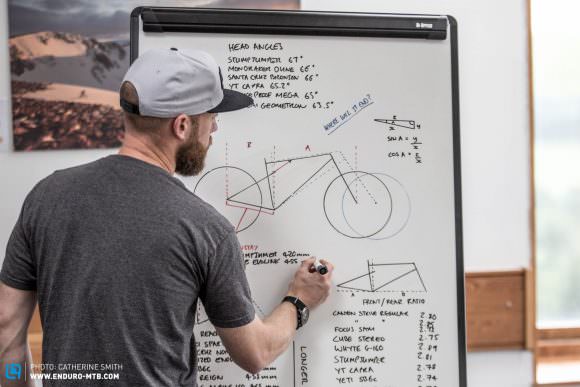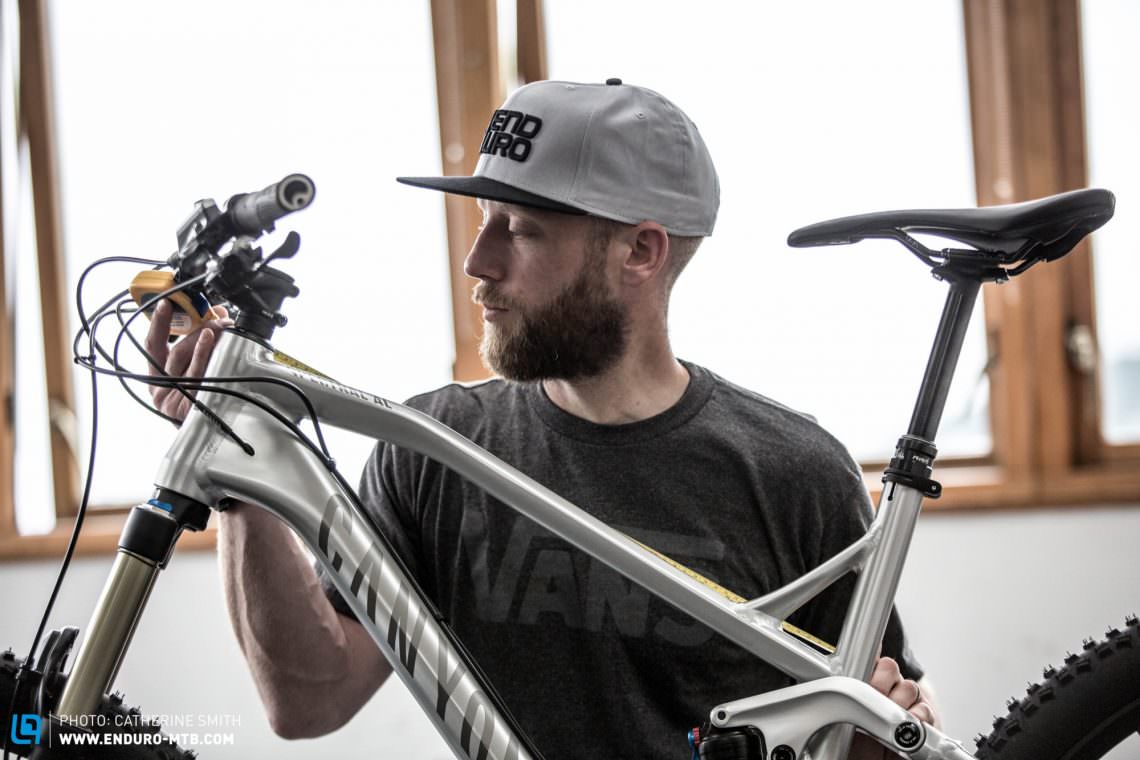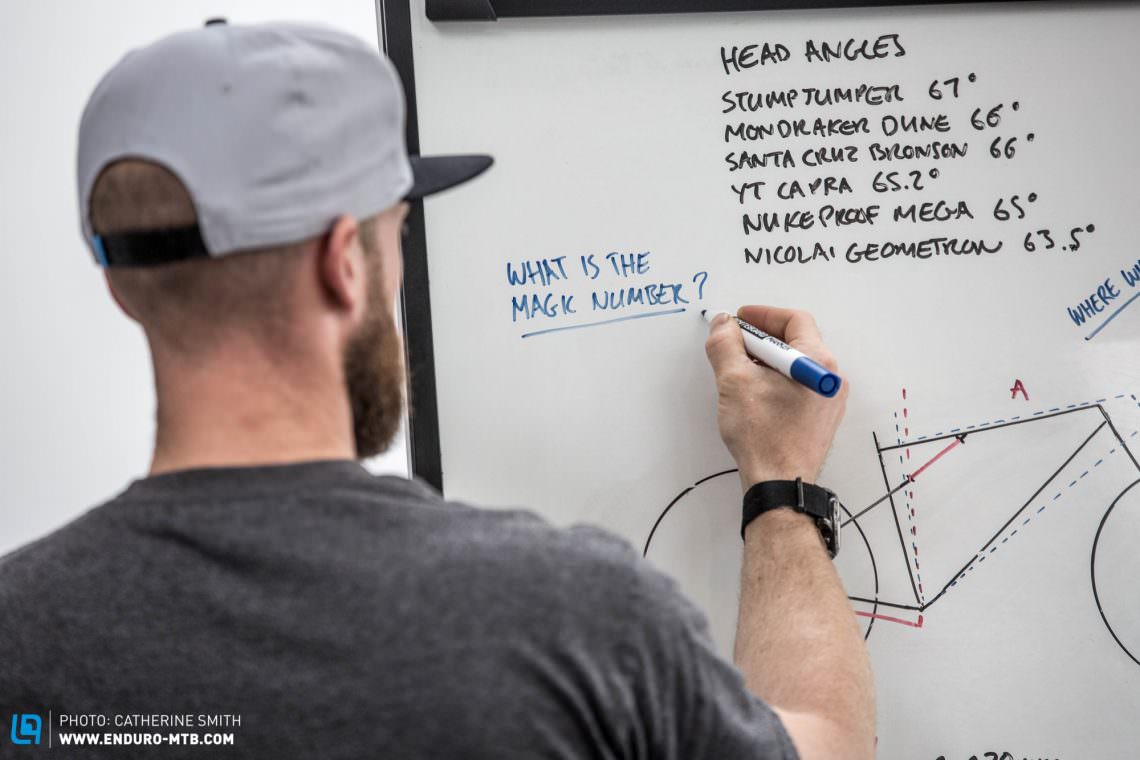Over the last few years there has been a geometry coup going on in enduro bike design, with marketing departments across the industry clamouring to shout their message the loudest – “To go fast, you need long and slack.” The voices were so strong that many riders went out to their bike sheds armed with tape measures, and after some quick calculations burst out shouting, “That’s why I cannot get STRAVA KOMs! It’s because my bike is 15 mm too short!”
Is this all hype? Are longer and slacker bikes simply better? If we compare most of the bikes we ride today with the bikes of say ten years ago, then yes – we have generally seen a big change. Bikes are now longer in the front centre (from the BB to the head tube) and wheelbase, and slacker in the head angle (while steeper in the seat angle) – but are they better? Damn right they are! But what about differences within the bikes on the market today? Aside from a band of mavericks doing their own thing, innovation in geometry has slowed somewhat, and best-selling bikes are now far more homologous. Just like modern cars, if we remove the manufacturers’ brand heritages and suspension acronyms, after drilling bikes down to their basic numbers there really isn’t much in it, with most now sharing very similar blueprints. We have reached a geometry ideal that offers good performance in most situations and for most riders, and while for many brands this is still conservative when compared to the extreme geometries of the maverick brands, many brands still label their advertisements with the over-hyped “lower, longer, and slacker.”


Are race-winning bikes the longest, lowest, and slackest?
So what about the race-winning bikes on the market at the moment, the ones that have stolen podiums on the international circuit: where do they fit into the geometry landscape? Bikes like the Yeti SB6c, Santa Cruz Nomad, YT Capra, and Canyon Strive (regular, not race geometry) have all demonstrated their potent performance on stages of the Enduro World Series; surely these big-hitting bikes are at the pinnacle of the long and slack spectrum? Well, surprisingly, no they are not, far from it. These iconic bikes sit in the middle, neither short or long, steep or slack. There are bikes on the market that offer much more radical dimensions – these are the heretics, the mavericks who have departed from the tried and tested formula, no longer playing it safe. Brands like Nicolai, Mondraker, Pole and Whyte are producing bikes so long and slack that the competition are left looking like pumped up BMX’s – but have they gone too far?
What the hell is a ‘normal’ enduro bike anyway?
Before we look at the exceptions, we need to understand what a ‘normal’ enduro bike looks like. We analysed twenty-five of the most popular 150 – 160mm enduro bikes, measuring every dimension and angle. After crunching the data, and excluding the very radical Pole and Nicolai Geometron we reached a conclusion – a ‘collective’ blueprint for a modern enduro bike. We can say with confidence that the ‘collective’ size large enduro bike of 2016 has a 1202 mm wheelbase, a 431 mm chainstay, a 65.8 o head angle, and a reach of 453 mm. It’s amazing how many of the current bikes on the market sit close to these numbers! Indeed, there was one bike that was very close! The Focus SAM’s vital statistics of 1198 mm, 430 mm, 65.8 o, and 452 mm respectively almost identically represents the definitive ‘collective ideal.’ But what of the Pole EVO Link 150 27.5 and Nicolai Geometron, bikes with a far more extreme take on the concept? With wheelbases of 1314 and 1325 mm respectively, and head angles of 63.5 o, over 13 cm longer than the Large Santa Cruz Nomad, and 2.5 degrees slacker – a huge amount in a world defined by minutia.

So why should I go slack?
So why go slack? We only have to look at the differences between a DH bike and XC bike to understand the benefits of a slacker head angle. A slacker head angle makes the bike feel less nervous, more confident, and more stable through rough terrain, and more forgiving when the trail gets steep. Placing the front wheel farther forward from the rider’s hands provides a more controlled feeling on steep descents, soaking up impacts without pitching the rider too far forward. “Long and low” chief heretic and inspiration behind the Nicolai Geometron Chris Porter adds: “My take is that the front must be long enough and the front wheel far enough away to allow the rider to lean forward into the turn and to load the front wheel (to a certain extent) through the handlebars. A short front centre forces you to load the front wheel through the feet, leaving no choice to lean forward and allow your weight to fall forward under deceleration. Try to get them turned whilst leaned over at speed and the small rider space at the front means the rider can’t get down behind the front wheel to drive it.” But can you go too far? An extremely slack head angle really sings when driving hard on very steep terrain, but at more mundane speeds on less technical trails that driving rock song soon becomes more of a euro-pop disaster. Super-slack bikes feel lethargic and dead at lower speeds on mellower terrain; wandering lazily up the climbs as the front wheel hunts from side to side unless the rider knows how to weight the wheel properly.

It’s not the length, it’s how you use it!
Length is important too. We have seen most bikes grow 20 – 40mm over the last three years, giving the rider space to move around over the bike; however, a long front centre (from the BB to the head tube) doesn’t automatically guarantee better handling. Good handling is a product of many factors – it’s not the length, but how you use it! Canyon designer Daniel Oister adds, “It all depends on the trails you ride, the speeds you ride them, and whether your focus is on fast times or just fun. Longer bikes give you more stability, and a longer front center helps, especially on steep descents. With a central riding position on a long bike, the rider doesn’t need to move about so much, which helps on fast trails. If you have a shorter bike with a short front center, then you have to move about a lot more to stay in control. However, longer bikes are harder to ride on flat and twisty trails where speeds are generally slower, as you have to push the bike around more. That’s why we have different geometries for different categories. A Spectral is shorter than a Strive to make it more agile because it’s intended as a fun trail bike, and less of an enduro race bike. It’s all about finding the right balance.”


So why not have a long front centre and ultra-short chainstays?
While front centres of bikes have been steadily growing, chainstays have been getting shorter. The universal acceptance of 1x drivetrains has allowed designers to free themselves from the need for a front mech, creating space to bring the back wheel closer to the bottom bracket. Of the enduro bikes we surveyed, the chainstays ranged from an ultra-short 420 to a lengthy 455 mm, with most brands settling for a figure halfway between the two. While shorter chainstays do make a bike more maneuverable, ultra-short chainstays reduce high speed stability and influence the rider’s position on the bike, moving the rider’s weight distribution rearwards towards the back wheel, away from the front. When combined with a very long front centre like the Canyon Strive (Race geometry) and Whyte G-160, less aggressive and dynamic riders will find it very difficult to weight the front wheel in turns, a bit like driving your car from the rear seats. These out-and-out race bikes demand a very aggressive attack position to shine, a position that is often unattainable by the recreational rider. For most riders balance is key, and unsurprisingly most of the biggest brands steer clear of extremes.
Don’t believe the hype – balance is key!
So perhaps we have the answer: it’s not all about ‘low and slack,’ or ‘long or short,’ it’s about balance. Wading through the reams of geometry data on wheelbase, angles, front/rear ratios, reach, and kinematics – it’s clear that the powerhouse brands and most iconic bikes often fall near the middle ground, progressive enough to be considered ‘aggressive’ without being too extreme or demanding too much from the normal rider. More Led Zeppelin than Bryan Adams, but certainly no Iron Maiden. In the end, there’s no magic bullet: ‘good handling’ cannot be defined by one or two dimensions alone, but is a symbiotic relationship between rider and bike. On the trail, geometry is no longer confined to static dimensions, but is constantly shifting as we weight the pedals and drive through turns. Ratios change and weight slams forwards and backwards, making design and setup of suspension play a pivotal role. Just because your bike has slightly longer chainstays doesn’t mean you can’t rail berms or cut through sharp turns; if your front centre isn’t stretched to the horizon it doesn’t mean you can’t smash fast descents, technique and riding style play a larger part. How we ride, where we ride, and our own personal geometry all shape the bike that will best suit our needs. Do you have the skills to threaten the top steps of podiums, or do you measure your riding more on fun and enjoyment?

Like everything in life, in the end it comes down to balance. While super-long and slack geometry is perfect for those lucky enough to live near challenging terrain, and for racers who ride everything at 100%, spending every second of the descent on the red line, it is not for everyone! For those who prefer their rides at a more comfortable speed, and who don’t live near EWS terrain, a more balanced geometry may be the secret to unlocking more fun. ‘Longer and slacker’ has been the buzzword, but balance is key – don’t believe the hype.
Did you enjoy this article? If so, we would be stoked if you decide to support us with a monthly contribution. By becoming a supporter of ENDURO, you will help secure a sustainable future for high-quality mountain bike journalism. Click here to learn more.
Words: Photos: Catherine Smith









